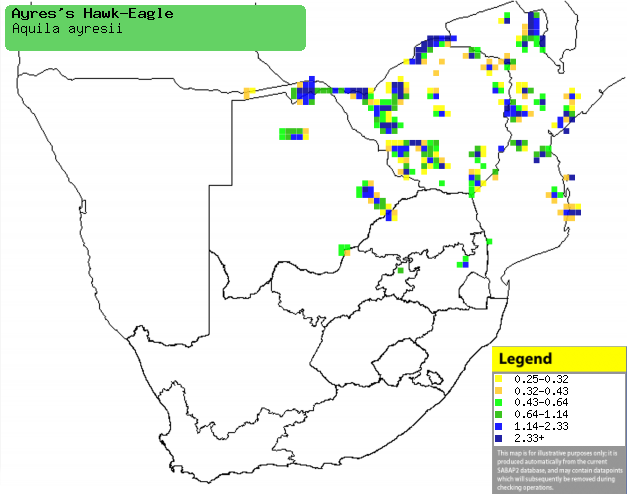|
Aquila ayresii (Ayres' hawk-eagle, Ayres' eagle)
[= Hieraaetus ayresii]
Kleinjagarend [Afrikaans]; Ayres-havikarend
[Dutch]; Aigle d'Ayres [French]; Fleckenadler [German]; Įguia de
Ayres [Portuguese]
Life
> Eukaryotes
>
Opisthokonta
> Metazoa
(animals) > Bilateria > Deuterostomia >
Chordata > Craniata > Vertebrata (vertebrates) > Gnathostomata (jawed
vertebrates) > Teleostomi (teleost fish) > Osteichthyes (bony fish) > Class:
Sarcopterygii (lobe-finned fish) > Stegocephalia (terrestrial vertebrates) >
Tetrapoda (four-legged vertebrates) > Reptiliomorpha > Amniota >
Reptilia
(reptiles) > Romeriida > Diapsida > Archosauromorpha > Archosauria >
Dinosauria (dinosaurs) > Saurischia > Theropoda (bipedal predatory
dinosaurs) > Coelurosauria > Maniraptora > Aves (birds) >
Order: Falconiformes
> Family: Accipitridae
> Genus: Aquila
Distribution and habitat
Occurs in isolated patches of sub-Saharan Africa. In
southern Africa, it is rare in Zimbabwe, central
Mozambique, the Caprivi Strip (Namibia), northern and south-eastern Botswana and
north-eastern South Africa. It generally prefers dense woodland, forest edges
and well-wooded suburbia, often roosting in stands of Eucalyptus trees.
|
 |
|
Distribution of Ayre's hawk-eagle in southern
Africa, based on statistical smoothing of the records from first SA Bird
Atlas Project (©
Animal Demography unit, University of
Cape Town; smoothing by Birgit Erni and Francesca Little). Colours range
from dark blue (most common) through to yellow (least common).
See here for the latest distribution
from the SABAP2. |
Movements and migrations
Some populations are resident and nomadic,
while others are intra-African breeding migrants. It is a non-breeding
summer visitor to South Africa in the period from January-April.
Food
It almost exclusively eats birds, especially doves and
pigeons, soaring high above the ground in search of prey. Once it singles out a
bird, it steeply dives to intercept it in mid air. The following
food items have been recorded in its diet:
Breeding
- Little known in southern Africa, although it has been well-studied in East
Africa; it is a monogamous, territorial solitary nester.
- The nest is built by both sexes, consisting of a platform of a twigs and
sticks, lined with green leaves and typically concealed in the fork of a
well-foliaged, large tree.
- Egg-laying season is from April-September, peaking from April-May.
- It lays a single egg, which is mainly incubated by the female for about
43 days, while the male brings her food every 2-3 days.
- The chick is fed once every day or so, leaving the nest at about 73 days
old and becoming fully independent roughly three months later.
Threats
Not threatened globally, but Near-threatened in South
Africa, as it is rare in the country due to loss and degradation of woodland,
especially miombo (Brachystegia). It is also persecuted due to its
tendency to kill homing pigeons, and other domestic birds.
References
-
Hockey PAR, Dean WRJ and Ryan PG 2005. Roberts - Birds of
southern Africa, VIIth ed. The Trustees of the John Voelcker Bird Book
Fund, Cape Town.
|
